The history of the piano within 5 minutes
The piano is a musical instrument that needs no introduction. The “King” instrument as many like to call it, it enjoys unshakeable popularity and is present absolutely everywhere around us.
Yet, this instrument isn’t as ancient as one might think if we really consider it! However, it has undergone remarkable evolution over the centuries. Let’s discover the history of the piano together, shall we?
Before looking at the history of the piano, we must remember what was used before it! Because yes, instruments similar to it were already making their mark.
The first keyboard instruments
Before the piano, musical instruments such as the clavichord or harpsichord were very popular. These were revolutionary due to their ability to produce sound via keys. But how did they work?
The clavichord
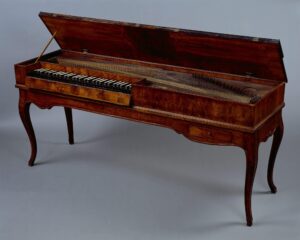
The clavichord is a struck string instrument that traces its origins to the Middle Ages. Its mechanism is indeed quite simple – the keyboard keys activate small metal pieces that strike strings, in the same way as a traditional piano.
Its very interesting characteristic comes from the fact that it was already possible on this instrument to vary the intensity of the sound as well as its length. For that era, this was a real technical achievement that allowed the clavichord to build an important and solid reputation.
The harpsichord
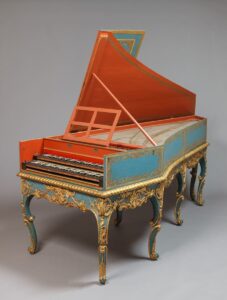
As for the harpsichord, it is a plucked string instrument. Here, the sound is therefore produced by plucking the strings and not by striking them. Thus, when a key is pressed, it activates a mechanism that, when rising, will release the string and make it vibrate.
Unlike the clavichord, the harpsichord can produce a much more powerful sound, which allows it to be used in concert halls alongside other instruments. It was moreover widely used in the Baroque and Classical periods.
But what marks a significant turning point in the history of the piano is undoubtedly the appearance of the fortepiano.
The invention of the fortepiano
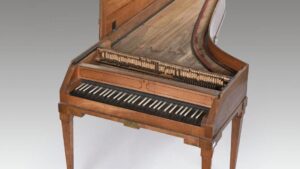
The fortepiano is a true revolution in the history of the piano. This precursor to the modern piano was invented by Bartolomeo Cristofori at the beginning of the 18th century. The fortepiano is therefore an improvement on the two previous instruments. It indeed adopts the advantages of the clavichord, namely nuanced playing, but also those of the harpsichord, namely powerful playing.
These models were however not very accessible because their manufacturing complexity made them very rare and therefore very expensive. They nevertheless managed to establish themselves over time, so much so that the most famous composers such as Mozart and Beethoven composed extensively on these instruments.
The history of the piano from the 18th to the 20th century
The history of the piano constantly evolves to shift toward an instrument that increasingly resembles the one we know today. Several stages will establish this significant evolution.
Manufacturing improvements
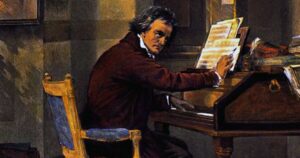
To return to Beethoven, he truly pushed fortepiano manufacturers to improve their instruments in order to meet his demands in terms of sonority and resistance. Indeed, Beethoven played with such intensity that it was not uncommon for him to literally destroy the instruments he practiced on…
This composer so exploited the limits of the fortpiano that it was vital for builders to improve their instruments. This is how the evolution took place. Over the years, we would therefore benefit from more robust frames and improved mechanics.
The peak of the romantic piano
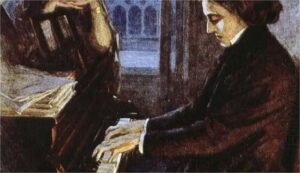
After Beethoven, we can cite two monuments of the Romantic era, namely Chopin and Liszt. These virtuoso composers of the Romantic period exploited to their maximum the expressive capacities of the piano. Chopin was a lover of the Pleyel manufacturer, while Liszt swore only by the Erard brand.
Once again, these manufacturers were able to evolve their instruments to meet the increasingly demanding requirements of composers of this era, some of whose works required exceptional or even superhuman virtuosity.
The history of the piano in industrial innovation
The 20th century arrives and the industrial development of this era allows for much more substantial piano production. This will make the piano much more accessible to the general public, whereas it had remained quite elitist at the time.
This century will also introduce us to legendary pianists like Vladimir Horowitz or Arthur Rubinstein who greatly contributed to the democratization of the piano. It’s also during this era that jazz explodes in popularity, allowing the history of the piano to mark a decisive turning point in its expression.
The history of the piano today
Today, the piano is everywhere and present in all its forms. Digitization even allows for new solutions like the advent of the digital piano, an ideal solution to allow everyone to start playing this musical instrument without paying a high price.
Numerous technological innovations such as the hybrid piano popularized by Yamaha are currently marking a significant turning point in the history of the piano. The current century and the one to come thus promise many surprises in the evolution of the piano as we currently know it.
The history of the piano is therefore rich and fascinating, tracing back to its origins is thus an excellent way to better prepare for its future which seems more than promising.
